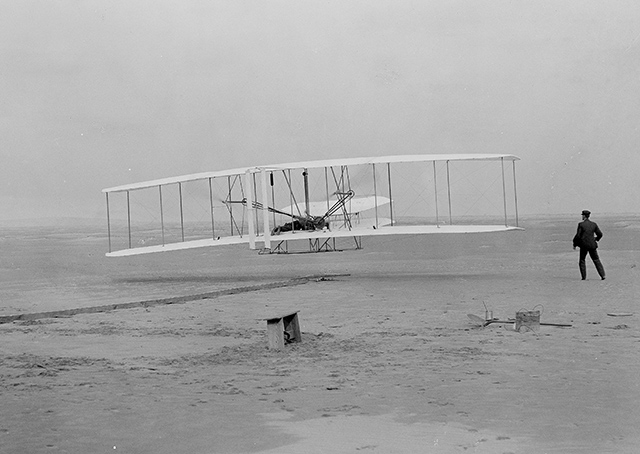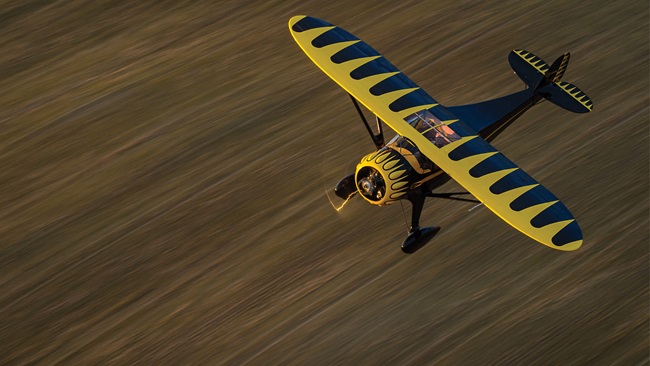
Aviators celebrating the freedom of flight can thank two bicycle-building brothers from Ohio who risked bumps and bruises to launch their gasoline-powered, wood-and-fabric invention into a strong North Carolina wind on Dec. 17, 1903.
Most pilots know the story of the Wright Flyer’s 120-foot maiden voyage from a sand dune in Kitty Hawk, but there’s a lot more to find out about Orville and Wilbur Wright. These five fun facts will increase your aviation knowledge about that famous takeoff 112 years ago.
Famous photo
The iconic image of Orville Wright’s first flight with Wilbur running alongside the right wing as the craft broke Earth’s gravity almost didn’t happen.
U.S. Life-Saving Service Surfman John T. Daniels had unknowingly been thrust into the limelight when he was tasked with operating Wilbur’s boxy Korona-V glass-plate camera that was staked into the sand near the brothers’ launching ramp.
Daniels began his morning by helping the Wrights maneuver their Wright Flyer to its starting position atop a simple monorail guide, and he ended the day with the Flyer crumpled around him after a crash that he miraculously escaped without injury. But the time in between was pure magic—and Daniels’ black-and-white image was forever etched into history.
Wilbur had set up his large camera on a tripod and pre-focused on a spot that he believed would capture the flyer’s first ascent. Even though Daniels hadn’t operated a camera before, Wilbur chose him to be the photographer and gave him a brief lesson in the finer points of camera operation. Large glass-plate images produced a decent image, but photographers had only one shot to capture the moment.
At 10:35 a.m., with Orville piloting, the aircraft started down the monorail track, traveled 40 feet, and flew.
Daniels said later that he was so excited he nearly forgot to squeeze the camera bulb, which would trigger the shutter. Fortunately he did remember to take the picture, and the photo became known worldwide as the single piece of photographic evidence from the world’s first powered flight.
The brothers made most of the photographs themselves between 1897 and 1928, and the collection provides a unique visual record of their labs, engines, experimental airplanes, runways, flights, and accidents. The Wright brothers’ estate gave the Library of Congress 300 glass-plate negatives, including the Daniels' photo, and two nitrate negatives documenting their successes and failures with flying machines.
In a 1927 interview with Collier’s Weekly, Daniels recalled his days as a Coast Guardsman observing the Wrights’ experiments on the beaches of North Carolina. “We knew that they were going to fly, but we didn’t know what was going to happen when they did. We had watched them for several years and seen how they figured everything out before they attempted it. We had seen the glider fly without an engine, and when those boys put an engine in it we knew that they knew exactly what they were doing.”
Humble beginnings
The Wright Brothers author and historian David McCullough notes that the Wrights grew up in a small Dayton, Ohio, apartment without electricity or running water. However, the family had access to books and the parents prompted the brothers to read often.
Wilbur experienced a hockey accident as a child that knocked out several teeth and ultimately kept him at home where he discovered aviation through books on the subject. “That really launched him in his historic career,” McCullough said during a video interview.
The Wright brothers spent about $1,000 total and invested only their own money on the flying project, McCullough said. “Modesty was one of the prime virtues to try and obtain and they were that way all of their lives.”
After they flew their historic first flight from Kitty Hawk, McCullough said the world didn’t even blink an eye. “The country, Washington, D.C., the reporters from the newspapers in their own home town, refused to believe these two men had flown. Nobody took an interest except the French. A delegation of French military officers came all the way across the [Atlantic] ocean to Dayton, and the first flight flown before the public was on Aug. 8, 1908 … at LeMans, France. At that point the world was astonished in a way the world had never been astonished, and the Wright brothers became celebrities instantly, overnight.”
McCullough’s book says the brothers were introduced to flight by their dad, Milton Wright, a traveling church bishop who was a voracious reader, a stout pacifist, and the editor of the United Brethren Church newspaper called the Religious Telescope. As such, on one of the elder Wright’s journeys, he brought home a rubberband-powered helicopter modeled after the designs of French scientist Alphonse Penaud.
“The boys played with the toy—which they called a ‘bat’—until they wore it out, then began making their own copies. It was their first recorded experience with aviation,” according to the Wright Brothers Aeroplane Company’s website.
Wright Brothers blog
Before there were blogs, there were diaries, and the Wright brothers were prolific writers. Orville details the four flights he and Wilbur undertook Dec. 17. It’s a fascinating read on how the inventors approached their flight experiments, and it offers readers a behind-the-scenes viewpoint reminiscent of extra features on today’s Blu-ray Discs.
The Wrights’ first flight is notable to most pilots, and for good reason. However, their final flight of the day lasted nearly a minute, covered more than 850 feet, and produced one of the world’s first documented loss-of-control accidents in a powered aircraft.
“At just 12 o’clock Will started on the fourth and last trip,” Orville wrote. “The machine started off with its ups and downs as it had before, but by the time he had gone over three or four hundred feet he had it under much better control, and was traveling on a fairly even course. It proceeded in this manner till it reached a small hummock out about 800 feet from the starting ways, when it began its pitching again and suddenly darted into the ground. The front rudder frame was badly broken up, but the main frame suffered none at all. The distance over the ground was 852 feet in 59 seconds.”
Press release
Orville and Wilbur were not happy with the “instant” communication process back in 1903 and were intent on explaining a variety of errors that had been reported by the mainstream press. They didn’t have Facebook or Twitter accounts, but they knew how to fire off a nasty-gram to The Associated Press to clear the air, so to speak. Two weeks after their December flight, they tried to set the record straight, saying a telegram delivered to the Norfolk, Virginia, newspaper contained factual errors “by persons who never saw the ‘Flyer’ or its flights, of a fictitious story incorrect in almost every detail.”
The Norfolk Virginian-Pilot story they referred to claimed Wilbur was at the controls when the contraption “shot out into space” at a “high rate of speed” until it “slowly began to go higher and higher until it finally soared sixty feet above the ground.” The writer stated, “the invention hovered above the breakers and circled over the rolling sand hills at the command of its navigator and, after soaring for three miles, it gracefully descended to earth again and rested lightly upon the spot selected by the man in the car as a suitable landing place.”
Not wanting to let facts stand in the way of a good story, the writer concluded with Orville telling those gathered on the beach watching the maneuvers that the flight was a success before he shouted “Eureka.”
Orville was actually in the cockpit handling the flight controls while Wilbur was on the ground, and the real flight was less than the length of a football field.
The Wrights wrote that their first four flights occurred between 10:30 a.m. and noon when the wind blowing across the sand dunes reached velocities of 24 to 27 mph at the nearby Kitty Hawk weather station. They said their flight paths were intentionally targeted into the wind and kept low to the ground for safety. Remember, neither one had any experience piloting a powered flying vehicle, so many of their theories about flight were worked out quite literally on the fly.
“The height chosen was scarcely sufficient for maneuvering in so gusty a wind and with no previous acquaintance with the conduct of the machine and its controlling mechanisms,” they wrote. Orville piloted two flights and Wilbur warped the wings for two more flights. “After passing over a little hummock of sand, in attempting to bring the machine down to the desired height, the operator turned the rudder too far; and the machine turned downward more quickly than had been expected,” they wrote to the AP, ending their day when pilot error snapped off the aircraft’s front-mounted rudder.
A.I. Root, a beekeeper, had befriended the Wrights and was in the right place at the right time to witness and report on the brothers’ subsequent flights after they returned to Dayton, Ohio. Root wrote three articles in his Gleanings in Bee Culture journal that substantiated the Wright’s claims. Root’s folksy writing style and his inserting an aviation article in between stories about pollinators and honey-judging captured the attention of the journal’s readers and gained notoriety for Root and for the inventors.
‘Not a crank’
The Wright’s long relationship with the Smithsonian Institution began in 1899 when Wilbur wrote to the museum to obtain information on human flight.
“I am an enthusiast,” Wilbur wrote, “but not a crank in the sense that I have some pet theories as to the proper construction of a flying machine.”
The Wrights were smitten by flying and were keenly interested in learning how to design an aircraft that would avoid fatal accidents like the glider crash that killed famed German experimenter Otto Lilienthal.
A Smithsonian official wrote back to Wilbur and sent him several pamphlets and a list of books. In a note to Wilbur, the official mentioned that a book called Experiments in Aerodynamics by the Smithsonian’s Samuel Pierpont Langley could be purchased for one dollar.Wilbur sent a thank you note and a dollar to purchase Langley’s work.
Balance and control issues were soon conquered by the Wrights, and less than five years later they were perched atop that hill at Kitty Hawk and ready to make history.
The Smithsonian says biographer Tom Crouch has called the communication “the most important exchange of correspondence in the history of the Smithsonian.”
The Wrights’ long but controversial history with the museum continues to this day. Biographer McCullough reminds pilots that pieces of wood and fabric from the Flyer were carried to the moon on the Apollo 11 lunar landing mission in 1969. The original 1903 Wright Flyer canard biplane has a 12-horsepower Wright horizontal four-cylinder engine driving two pusher props and is the centerpiece of the Smithsonian National Air and Space Museum’s “Invention of the Aerial Age” exhibit in Washington, D.C.



